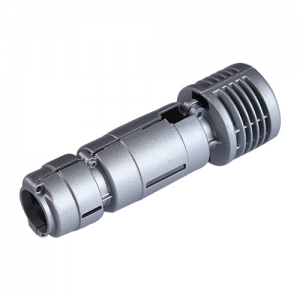Aluminum alloy die casting
- Product classification:Tool component
- product labeling:Aluminum alloy die casting
- Times of browsing:Already1031Customer focus
Performance characteristics of aluminum alloy die castings
1. Mechanical properties: When using die casting samples, the mechanical properties should meet the requirements of GB/T15115. When using the die casting body test, the mechanical properties of the cut-off sample at the specified location should not be less than 75% of the single cast sample. Dongguan aluminum alloy die-casting, aluminum alloy die-casting. 2, die casting size: die casting geometry and ruler
1. Mechanical properties: When using die casting samples, the mechanical properties should meet the requirements of GB/T15115. When using the die casting body test, the mechanical properties of the cut-off sample at the specified location should not be less than 75% of the single cast sample. Dongguan aluminum alloy die-casting, aluminum alloy die-casting. 2, die casting size: the geometry and size of the die casting should be in accordance with the provisions in the casting drawings. The dimensional tolerance of aluminum alloy die-casting and casting parts shall be in accordance with the provisions of GB6414. If there are special regulations and requirements, it shall be indicated on the drawings. Dimensional tolerances for die castings do not include casting pitch. When the die casting needs mechanical machining, the machining allowance shall be in accordance with the provisions of GB/T11350. 3, surface quality, casting dimensional accuracy, low surface roughness: casting surface roughness should meet the requirements of GB6060.1.
The aluminum alloy die-casting material refers to a device device of pure aluminum or aluminum alloy obtained by a casting processing method. Generally, a sand mold or a metal mold is used to pour aluminum or aluminum alloy heated to a liquid state into a cavity, and the obtained aluminum parts or aluminum alloy parts of various shapes and sizes are generally referred to as aluminum die castings. However, different aluminum alloy die castings will produce different types and effects. The performance characteristics of aluminum alloy die-casting parts are: good mechanical properties at room temperature; strong corrosion resistance; poor casting properties, large fluctuations in mechanical properties and wall thickness effects; long-term use, the plasticity of the alloy is reduced due to aging Even the phenomenon of cracking of the die-casting part occurs; the tendency of the die-casting part to generate stress corrosion cracking is also large. The disadvantages of the Al-Mg alloy partially offset its advantages, which limits its application. After the natural aging of aluminum alloy die-casting parts, high mechanical properties can be obtained. When the mass fraction of zinc is more than 10%, the strength is remarkably improved. The disadvantage of this alloy is that it has poor corrosion resistance, a tendency to stress corrosion, and is susceptible to thermal cracking during die casting. The commonly used Y401 alloy has good fluidity and easy filling of the cavity. The disadvantage is that the pores tend to be formed, and when the content of silicon and iron is small, it is easy to be thermally cracked. The aluminum alloy has the characteristics of large solidification latent heat and large specific heat capacity and small linear shrinkage coefficient of the silicon phase in the crystallization temperature interval alloy. Therefore, the casting performance is generally better than other aluminum alloys, and its filling ability is also better. Well, the tendency of hot cracking and shrinkage is also relatively small. The amount of brittle phase (silicon phase) contained in the Al-Si eutectic is the least, and the mass fraction is only about 10%, so the plasticity is better than that of other aluminum alloys, and the only brittle phase can be further processed by modification. Improve plasticity.
Previous page:Aluminum alloy die casting
next page:Magnesium alloy die casting






